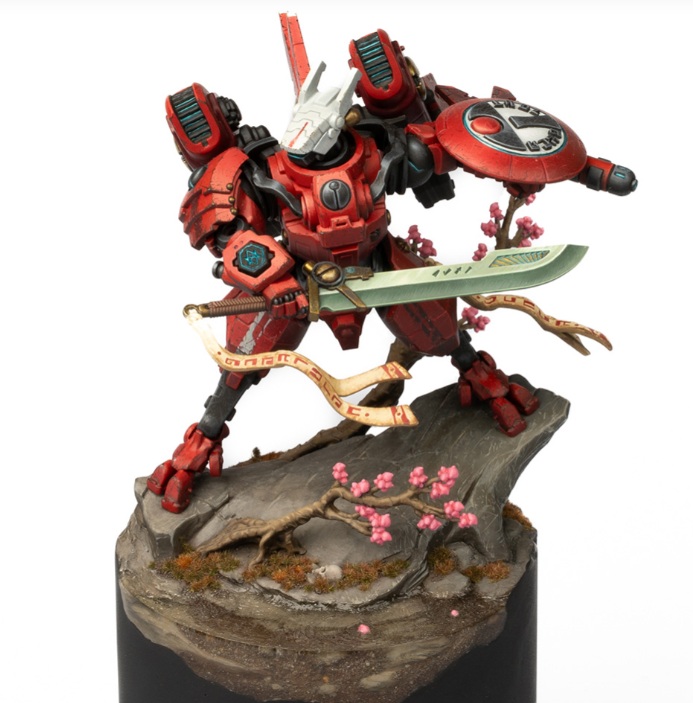A Battlesuit of Elegance and War
This miniature, painted by Golden Demon Adepticon finalist Andy Wardle, showcases a T’au Battlesuit posed with samurai-like poise atop a rocky outcrop adorned with delicate cherry blossoms. The entire presentation radiates grace and lethality, merging the high-tech aesthetic of the T’au Empire with a Zen-like sense of composition. The crisp red armor, accented with teal and ivory markings, gives the model an arresting presence while remaining faithful to the T’au’s sleek visual language. The dynamic stance, with the sweeping blade drawn mid-strike and shield at the ready, captures a moment of poised aggression. The scenic base, with the blossoming branches and moss-covered stone, enhances the martial serenity of the piece. It’s a stunning marriage of science fiction and traditional Eastern warrior themes.
Identifying the Battlesuit
The battlesuit depicted is a T’au XV86 Coldstar Commander, modified for dramatic effect. This is evident from its aerodynamic armor design, wing-like shoulder systems, and the command crest on its head. What makes this version unique is its melee loadout, which is atypical for standard T’au doctrine—typically favoring ranged warfare over close combat. The inclusion of a stylized katana, complete with trailing banners and runic etchings, gives it a character more akin to a duelist than a strategist. This may represent a custom battlesuit or an alternative interpretation of a Commander Farsight variant, who famously wields the Dawn Blade. Regardless, it’s a personalized expression of T’au innovation and iconoclasm.
The Lore of T’au Battlesuits
Battlesuits are the pinnacle of T’au military technology, offering unmatched mobility, firepower, and resilience. Designed to compensate for the T’au’s physical limitations in warfare, these suits allow their pilots—usually from the Fire Caste—to match or exceed the battlefield presence of Space Marines. Each battlesuit class is tailored to a specific combat role, from the agile XV25 Stealth Suits to the devastating XV104 Riptide. Pilots undergo intense training and are often bonded with their battlesuits through neural interfaces, granting split-second responsiveness. Commanders typically use more advanced suits like the Coldstar or Enforcer variants, enabling them to direct units and strike key targets with precision. Over time, these machines can gain nearly mythic status, becoming extensions of the pilots’ strategic minds and personal philosophies.
Aesthetic Storytelling in Miniature Form
Andy Wardle’s approach elevates this piece from miniature to storytelling art. The inclusion of cherry blossoms is more than just a visual flourish—it invokes the fleeting beauty of life, a theme deeply connected to samurai culture. The battlesuit’s katana and shield suggest a warrior who has stepped beyond the rigid doctrine of ranged supremacy into a more personal code of honor and combat. This paints the pilot not just as a commander, but as a warrior-philosopher, someone who perhaps challenges the Ethereal caste’s strict direction. The careful placement of every detail—the twist of the waist, the tension in the arms, the calm on the battlefield—reinforces this narrative. It’s a piece as much about identity as it is about firepower.
A Monument to the Greater Good
At its core, this miniature still represents the T’au ideal of the Greater Good—a belief system that binds the empire’s castes into a singular vision of unity, progress, and prosperity. However, the dramatic individuality of this model hints at the internal conflicts that can arise within such an ideology. Whether this battlesuit represents a breakaway Commander like Farsight or simply a philosophical reinterpretation of duty, it adds a layer of narrative depth to the typically clinical T’au aesthetic. It shows that within the sleek lines and drones of T’au warfare, there can still be room for honor, tradition, and artistic self-expression. That’s what makes this model so compelling—it doesn’t just embody the future of warfare, it imagines the soul within the machine. And in doing so, it leaves a powerful mark on both the tabletop and the imagination.


